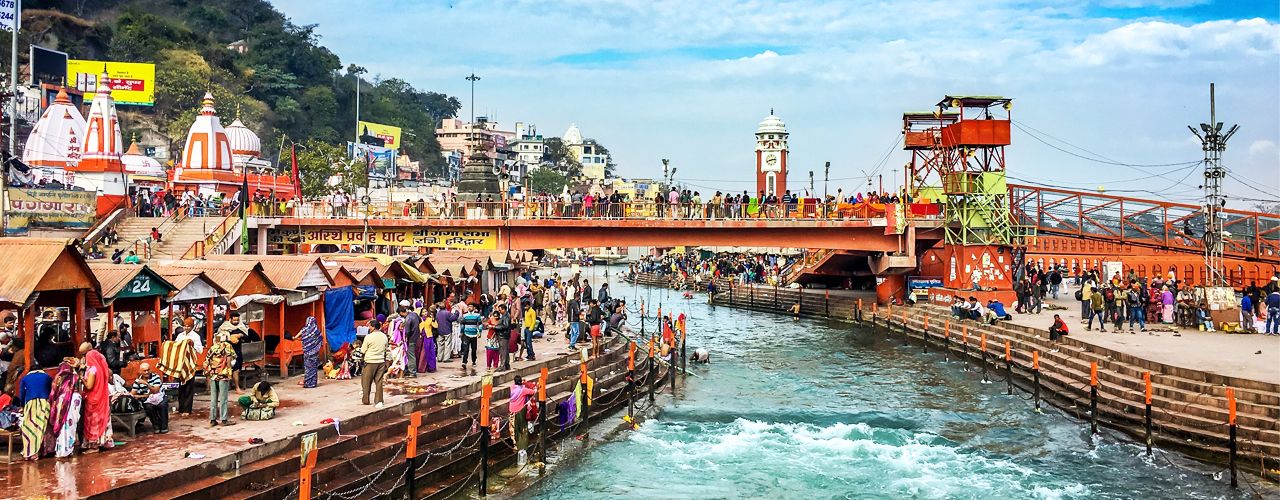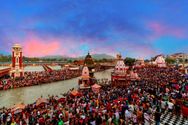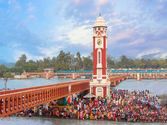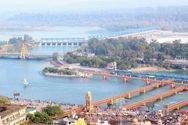- Get Directions
- Enquire Now
- Share
- Leave a review
- Improve Details
Haridwar overview
Haridwar is an ancient city and important Hindu pilgrimage site in North India's Uttarakhand state, where the River Ganges exits the Himalayan foothills. The largest of several sacred ghats (bathing steps), Har Ki Pauri hosts a nightly Ganga Aarti (river-worshipping ceremony) in which tiny flickering lamps are floated off the steps. Worshipers fill the city during major festivals including the annual Kanwar Mela.
Haridwar - Gateway to Land of Gods
As you step into the city of Haridwar you’ll be welcomed with the chimes of the temple bells and the religious chanting of the priests.The Haridwar city has a religious significance as the holy river Ganga enters the Indo-Gangetic Plains of North India for the first time in Haridwar. Thereby making its former name 'Gangadwara' perfect in every sense.
History of Haridwar
Haridwar is a living example of one such historical city that hasn’t been erased by the tides of time. The city has been mentioned in several Hindu texts, scriptures, and books from the times of Buddha to the British invasion. It was ruled by the Maurya Empire (322-185 BCE), followed by the Kushan Empire (c. 1st-3rd centuries).
In the Archaeological surveys, it was found that terra cotta culture thrived in Haridwar between 1700 BCE and 1200 BCE. Haridwar also finds its mention in the travel journals of the famous ancient explorers. During King Harshavardhan's rule (590-647) when Chinese traveler, Hsuan Tsang visited India in 629 A.D., he cited Haridwar as ‘Mo-yu-lo’ and also mentioned that there was a temple called 'Gangadwara' which stood in the north of Mo-yu-lo.
During the reign of Emperor Jahangir (1596-1627) Thomas Coryat, an English traveler who visited the city mentioned it as ‘Haridwar’, the capital of Lord Shiva. The city was first connected with railways via Laksar, through branch line in 1886. In 2000, Haridwar became a part of the Haridwar district of Uttarakhand which was carved out as a separate state from Uttar Pradesh.
Basic Information
Haridwar serves as the Gateway to the Char Dhams of Uttarakhand. The 'Panch Tirth' or the five pilgrimages located within the periphery of Haridwar are Gangadwara (Har Ki Pauri), Kushwart (Ghat), Kankhal, Bilwa Tirtha (Mansa Devi Temple) and Neel Parvat (Chandi Devi).
Other famous attractions include the Chandi Devi temple, Maya Devi temple, Piran Kaliyar, Neel Dhara Pakshi Vihar, Bhimgoda Tank, Bharat Mata Mandir, etc. Haridwar is one of the best places to head to if you are in a quest for peace and spirituality. One can do temple hopping, stroll along the river banks, have a holy dip in the Ganges or enjoy the serene atmosphere of the heavenly place.
You can visit some of the sacred Hindu temples and ashrams or rejuvenate your senses at the Ayurveda and Yoga centers. The auspicious Ganga Arti held at Har ki Pauri is a sight to behold, as the city is drenched in the divine aura of the glittering diyas and the ambiance is accentuated by the chanting of the mantras to appease the gods.
The tiny diyas bedecked by flowers appear as if thousands of lamps are set to float in the river. Haridwar also has a lot in store for the adventure enthusiasts as Rajaji National Park and Rishikesh are located on the outskirts of Haridwar.
Mythology about Haridwar
As per Hindu mythology, during the Samudra Manthan or the churning of the ocean, the precious drops of elixir or Amrit which carried the boon of immortality were accidentally spilled at four sites i.e Ujjain, Nasik, Allahabad, and Haridwar. To commemorate this event, Kumbh Mela, and Maha Kumbh Mela, the mass Hindu pilgrimages of faith is celebrated once in three years and once in 12 years at one of the four places respectively. It is believed that Brahma Kund situated at Har Ki Pauri is the place where the drops of elixir fell.
Places to visit in Rishikesh
Activities in Rishikesh
Cafes in Rishikesh
Backpacker Hostels in Rishikesh
Yoga Schools in Rishikesh
Events in Rishikesh
Religious Places in Rishikesh
Live Ganga Aarti
Explore the enchanting beauty of Rishikesh, where spirituality meets adventure amidst stunning landscapes & the sacred Ganges River.
Explore
ActivitiesPlace to VisitReligious Places Backpack HostelsCafes & RestaurantsYoga SchoolsEvents Copyright 2025 © Rishikesh.app | All rights reserved






